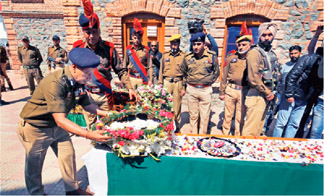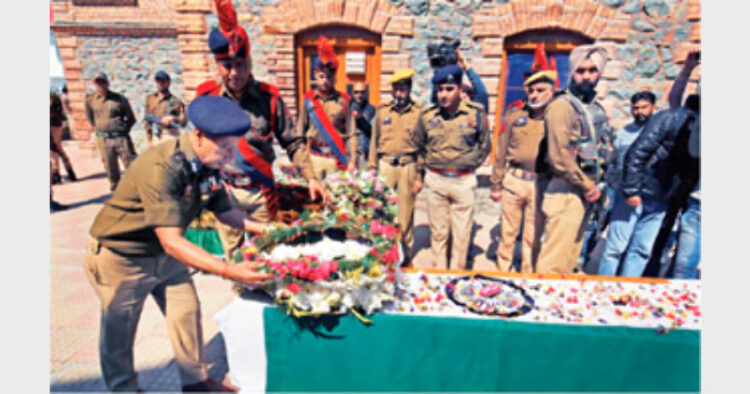 Kashmiri millitants decision to target J&K police and their families opens a new chapter in confrontation. It is time J&K police take lessons from Punjab Police
Kashmiri millitants decision to target J&K police and their families opens a new chapter in confrontation. It is time J&K police take lessons from Punjab Police
Brig (retd) Anil Gupta
Ever since the emergence of Burhan Wani as the poster boy of militancy and indigenous face of the so-called “resistance movement” in Kashmir, exploitation of social media by the terrorist outfits has become very common. Hizbul commander was known for posting photographs and messages using various forms of social media to lure the local youth to join militancy and also to communicate with the local population that had been radicalised and become sympathetic to the movement. After the death of Burhan Wani in an encounter with the security forces, use of internet was suspended in the Valley, in order to prevent misuse of the social media to act as a catalyst for the turmoil that engulfed the Valley in the aftermath of his death.
After the ban on use of internet was lifted Zakir Musa, a close friend of Burhan Wani and his successor as the operational commander of Hizbul Mujahideen, followed the footsteps of his predecessor as far as the use of social media to fuel militancy particularly in South Kashmir that had turned into a hotbed of the “resistance” movement. After a lull of about five months the
security forces resumed anti-terror operations in South Kashmir. The security forces launched successful operations, one after the other, resulting in killing of both local and foreign terrorists. Shaken by the dwindling strength of his cadre and resultant drop in their morale, Zakir Musa released many videos to raise the sagging morale of the terrorists and motivate the youth afresh in the typical ISIS style. However, the success graph of the security forces kept rising and the terrorists suffered one reverse after the other.
At this stage, Zakir Musa took the security forces by surprise by releasing two videos in quick succession. What surprised the security forces was the fact that the videos were not targeted at the militants’ cadre or local sympathisers but were used to convey an open terror threat to the police personnel and their families and the informers of the police. In the first video Zakir Musa threatened to attack J&K police and their families if they don’t stop harassing the families of militants. He further threatened policemen to stop targeting militants in the Valley or face dire consequences. “This is our first and last warning. Do not harass our families, otherwise we will kill yours. Even if your families were in Kanyakumari, we’d hunt them down and kill them. If you still don not refrain from doing so, we will make sure that every street in the Valley is littered with the bodies of J&K policemen. Even police security will not be able to protect them”, thundered Zakir Musa in the 25 seconds video. In the same vein he also threatened the police informers.
The newly-appointed Director General of J&K Police Dr S P Vaid was quick to respond when he stated that the Police were not harassing militants’ families and warned them that in case they dared to target police families,
terrorists should not forget that they also have families living back in the villages. In a subsequent video issued in March last Musa said, “Many people say local policemen are our own. Don’t think they are our brothers. They are supporting infidels and this is my last warning before beginning of the war.”
What was the intention of the terrorist commander in issuing these threats? He obviously was doing so at the behest of his masters sitting across the line of control, in order to demoralise and subvert the local policemen. Pakistan expected the Kashmiri policemen to react and resign en-masse quoting threat to their families as an alibi. This would have enabled Pakistan to
portray the situation in Kashmir as an indigenous home-grown movement. Similarly, by invoking Islam, it wanted to divide the state of J&K on the religious lines as a continuation of two-nation theory. Pakistan failed miserably in its designs, thanks mainly due to the fine leadership provided by the DGP and his team of dedicated local Kashmiri
officers and the steel-like resolve of nationalist Kashmiris.
Three police families were targeted in succession but this also failed to cow down the brave officers and policemen of Jammu & Kashmir Police (JKP). Frustrated and angry Musa released another video on April 1. He threatened, “Anyone who sides with JKP or the Indian Army automatically by being
associated with them becomes anti-Islam. They are betraying fellow Muslims and should be punished suitably.” He, in this video, also showered praises on the stone-pelters and called them soldiers of Islam. “Stone-pelters are doing a noble task by protecting the mujahids. Stone-pelters are soldiers for Islam.” This was another attempt to play the religion card to win over the Kashmiris and open admission of the terrorist-stone-pelters nexus.
Stone-pelters are neither terrorists’ sympathisers nor soldiers of Islam but proponents of terror. They are the enemies of the nation.
So far, JKP has resisted from the “tit for tat” policy and refrained from hitting back at the terrorists’ families. In my view, this strategy of the militants may prove to be counter-productive. JKP has the Punjab model to fall back upon, if pushed to the wall. The
militancy in Punjab was controlled by the Punjab Police under the superb leadership of KPS Gill, only after the militants started killing and
torturing the families of Punjab policemen. The Punjab Police took upon itself the mantle of
taking the militants head- on and not sparing the families of the militants that ultimately led to end of militancy.
I only hope the terrorists in Valley persist with their strategy and JKP under the leadership of its dynamic DGP repeats the history. For the protagonists of human rights, there is a counter-question, “Are the policemen and their families not human beings and entitled to human rights? Or is it the prerogative of the terrorists and their families only?” They are also advised to study how Russia dealt with the Chechen rebels, how China is handling the Uyghur crisis in the restive Xinjiang province bordering Gilgit-Baltistan and much closer how Pakistan has used the sledge-hammer against the fighters of Tehrik-Taliban Pakistan using gunships, attacked helicopters, bombers and artillery in operation Zarb-e-Azb and in recently launched operation Radd-ul-Fassad in the hinterland.
Time has also come for the disgruntled Kashmiris to choose between “terrorism” and “tourism”. It is not Hobson’s choice. Those who opt for the former, including those who glorify the stone-pelters and call them “nationalists”, will be termed anti-nationals. The nation’s might should be used to crush them. In the changed Kashmir narrative there is no place for those who are against the nation’s unity and integrity.
(The writer is a Jammu based political commentator, columnist, defence and strategic analyst)














Comments